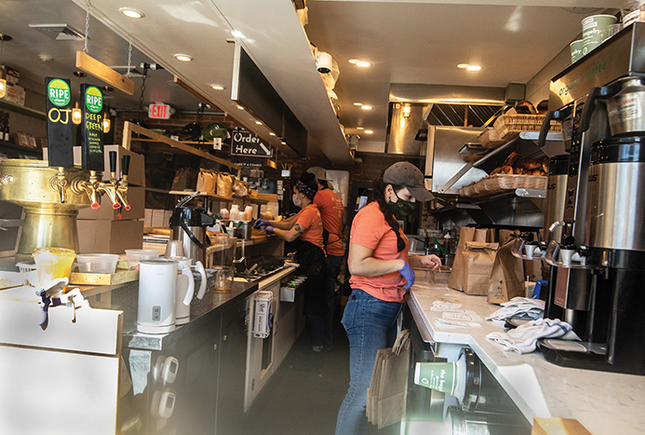
Mark Ostow
Restaurants like The Bagelry, part of Olmo in New Haven, retooled kitchens for the pandemic era.
View full image

Mark Ostow
Restaurants like The Bagelry, part of Olmo in New Haven, retooled kitchens for the pandemic era.
View full image
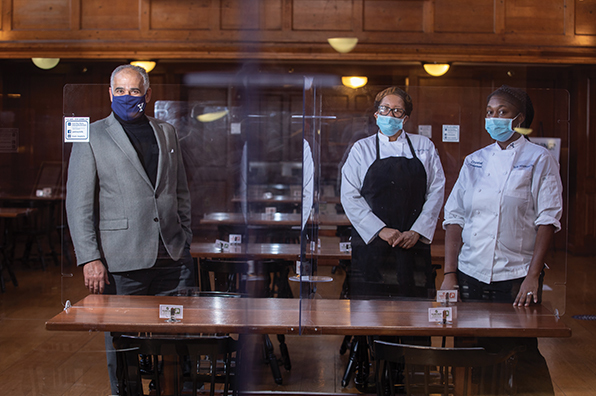
Mark Ostow
Rafi Taherian, associate vice president for Yale Hospitality, says Yale dining will never be quite the same: “We’re never going back to the same processes” of menu writing and food purchasing. He is pictured here in the dining hall of Timothy Dwight College with pantry worker Wanda Underwood (center) and Crystal Coleman, a third cook (right).
View full image

Mark Ostow
Rafi Taherian, associate vice president for Yale Hospitality, says Yale dining will never be quite the same: “We’re never going back to the same processes” of menu writing and food purchasing. He is pictured here in the dining hall of Timothy Dwight College with pantry worker Wanda Underwood (center) and Crystal Coleman, a third cook (right).
View full image
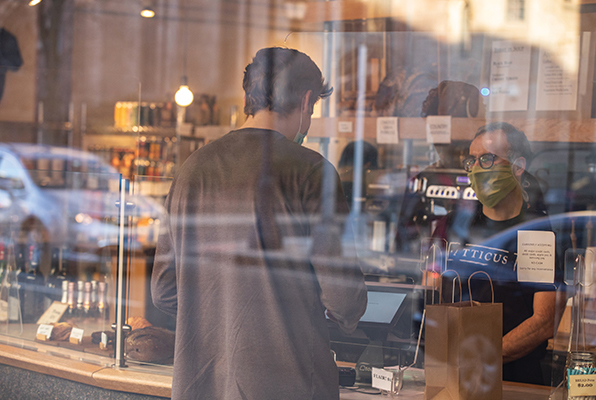
Mark Ostow
Atticus, the bookstore café on Chapel Street, moved to an all-takeout model for the duration of the pandemic.
View full image

Mark Ostow
Atticus, the bookstore café on Chapel Street, moved to an all-takeout model for the duration of the pandemic.
View full image
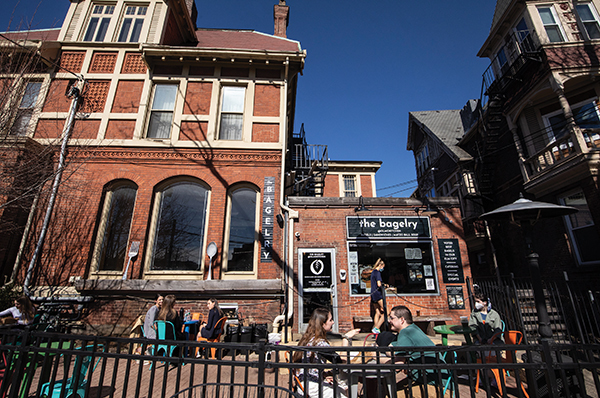
Mark Ostow
The restaurant and bagel maker Olmo offered prepared meals for reheating at home.
View full image

Mark Ostow
The restaurant and bagel maker Olmo offered prepared meals for reheating at home.
View full image
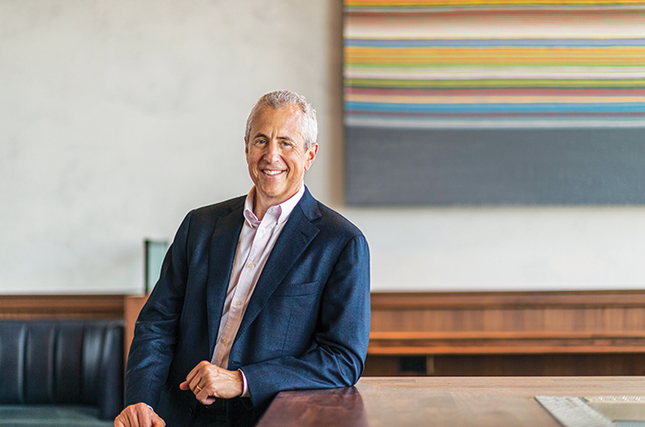
Daniel Kriege
Danny Meyer, founder of Shake Shack and a Yale parent, shifted his restaurant group to pick-up and delivery in the fall.
View full image

Daniel Kriege
Danny Meyer, founder of Shake Shack and a Yale parent, shifted his restaurant group to pick-up and delivery in the fall.
View full image
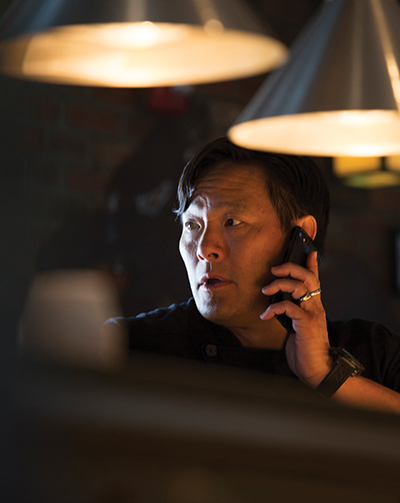
Mark Ostow
Chef Ming Tsai’86 launched Ming’s Bings, a national mail-order company.
View full image

Mark Ostow
Chef Ming Tsai’86 launched Ming’s Bings, a national mail-order company.
View full image
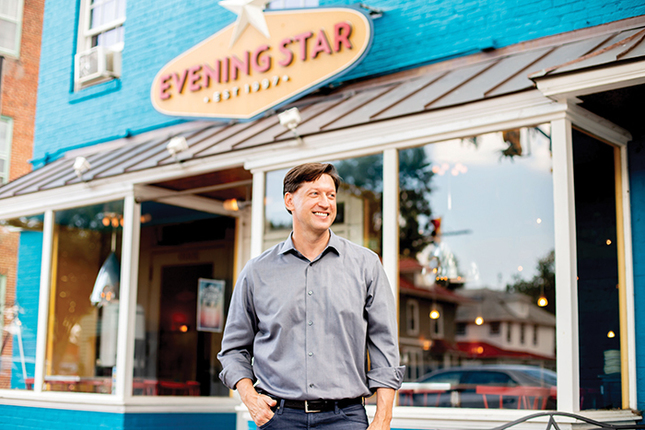
Stacey Windsor, Neighborhood restaurant group
The Neighborhood Restaurant Group’s Michael Babin ’90 plans to reopen 16 of 17 spots and has added two more.
View full image

Stacey Windsor, Neighborhood restaurant group
The Neighborhood Restaurant Group’s Michael Babin ’90 plans to reopen 16 of 17 spots and has added two more.
View full image
How to eat together during a pandemic? Families resorted to front porches, fire pits, garages with open doors. Restaurants had different options, and during the uncontrollable ride of 2020 they tried them all: “feeding the front lines” as a way to hire back workers; creating carryout food for the first time; mobilizing their own delivery services; buying plexiglass dividers and propane heaters; remaking their businesses as markets or meal-kit makers; purposing their restaurants as soup kitchens or “ghost kitchens” that sell several differently branded menus for carryout from the same small meal-prep area.
All was in the service of what families and diners craved as much as owners facing the greatest economic threat of their lives did: ways to keep a working team together in a business intensely focused on creating and maintaining community.
In Yale College
Building community is the essence of college dining, according to Rafi Taherian, the associate vice president for Yale Hospitality. “Food is secondary,” he says. “Our number-one focus is to create social interaction between students and faculty.”
Feeding students during the pandemic meant finding a new way to fit food into the form of family life that residential dining halls create. What restaurants were doing with to-go models, Yale’s dining services did too.
Dining halls: they, and playing fields, and singing groups, and theater sets, not to mention classrooms, are where lifelong bonds form. And of those, sharing meals is the great equalizer, regardless of a student’s own interests. How to provide anything like the communal experience of Commons, long closed for renovation, and also nourish students in the Yale College in loco parentis tradition?
The first challenge was logistical. Relying on the experience of Yale facilities in China—the most important lesson, counterparts told Taherian, was clear and open real-time communication—the hospitality department turned to providing sophisticated takeaway options, “completely contrary to what we did.” That meant not just huge orders for boxes and bowls but understanding what could and couldn’t be packed well. In: solids and dry food. Out: ramen, soups, anything liquidy. Not to mention salad bars and tapas bars and soup bars and huge condiment selections and the dozens of customizable options that had become college staples to compete for millennial favor.
As Taherian explains it, the menu changes amounted to fewer choices of higher-quality items. For any restaurant or dining service, the most expensive ingredients are proteins: meat, fish, cheese, dairy, even tofu. Thanks to new service restrictions, Yale Hospitality was able to spend more on higher-quality proteins. And also to measure out portion size—another strategy to both reduce the waste that results from many menu options and to use the savings on additional enhanced offerings.
Besides, post-millennials are less picky and spoiled, Taherian says, though he says it more tactfully: “They trust your choice if you’re good at what you’re doing. They want it authentic—but your way.” That means culturally appropriate dishes: no option to pour sriracha sauce on a croissant. It also means several options in each meal container: lunch could be “a beautiful bowl with something from Greece and a broccoli stir-fry, well matched and taken from a nutritionally based diet.” Students could pick from two entrée options per meal and know they would have a copious and balanced selection.
“It’s been tremendously successful,” Taherian told me at Christmas. Perhaps the staff’s greatest triumph were undergraduates’ TikTok videos about Yale food. They went viral; one attracted more than four million views.
“Grab and go” worked, and was what students wanted. What of dining halls and the bonding they foster? Going by state health department and other expert guidance, each of the 14 colleges “spent a fortune” on two- or three-foot-high plexiglass barriers between seats. Shouting through clear plastic might sound like a prison visit, and students apparently agreed. During the curtailed fall term, the weather was good enough that students who didn’t want to eat in their rooms could sit and meet in college courtyards. Those expensively refitted, de-densified dining halls were almost completely deserted in the fall term. Taherian says that having fewer staff and fewer meals—because so many undergrads stayed home or took the year off—made up for some of the plexiglass cost. (Many dining hall staffers were reassigned to other departments.) But then, having 14 college dining halls is hugely inefficient and expensive in the first place. One central dining hall would be far more cost-effective, but alien to the Yale College DNA.
Those colleges did provide a new kind of opportunity besides the ability to buy better ingredients: first-years who “bonded with each other like nobody’s business,” according to Charles Bailyn ’81, the A. Bartlett Giamatti Professor of Astronomy and Physics and head of Franklin College. In the fall term, Franklin had almost all its first-years; no sophomores, per Yale’s plan for the first semester; and a few dozen juniors and seniors. The result, he says, was “more college spirit in colleges than students have ever seen.” Franklin put up a tent in the courtyard, and that was where students invariably took their meals—unless weather or class schedules drove them to their rooms, where they were all allowed microwaves and mini-refrigerators.
As for dining halls: nope. When late fall weather turned too cold to make outdoor dining appealing, students just retreated to their rooms until the semester’s pre-Thanksgiving end. In the dead of February, sophomores returned to their colleges as planned; first-years stayed home, or off campus. Did grateful students commune within the warm dining halls? No. Dining halls remained ghost towns, and the plexiglass continued to gather dust. At best, Taherian reported at six weeks into spring term, ten percent of students were using dining halls to dine in. Everybody else ate in their rooms. “We thought their desire to eat” in a dining hall “would overcome” the plexiglass, Taherian said. “But it’s just not the same experience.”
What arrangements might last once all students were fully vaccinated? Taherian had just set that challenge to his team when we spoke in March. Preliminary plans included keeping food waste low: previously, he said, “we had two soups a night—two soups! One with meat, one without. Now we have one, usually vegan except clam chowder on Fridays.” Also, the pandemic’s lessons of reduced menu options would remain. Dining halls would provide “the highest quality ingredients,” but not excessively numerous choices. “We’re learning that providing variety does not mean the perception of value,” Taherian told me. Bowls with everything heaped in, meaning easy transport home to save leftovers, will likely stick around.
In New Haven
Despite the not-always-balmy New Haven weather and stringent restrictions on capacity, restaurants focused on making outdoor dining space attractive, as the high-end Union League Café did. Or they altered dishes to make them stand up to being carried out, as Olmo, the restaurant and bagel maker, did.
Most Yalies will remember Atticus, on Chapel Street, a popular bookshop and café-turned-full-service-restaurant, so successful that it spawned a wholesale and retail bakery called Chabaso. In the pandemic, Atticus followed the examples of the college dining service and many restaurants: make carryout dishes that could be quickly cooked to order and were easily eaten, like lasagna, or braised pork shoulder tucked into a banh mi roll.
Even when state rules allowed 50 percent dining-room capacity, Atticus stayed closed for all indoor dining. “We were concerned about the safety of our staff,” says Reed Immer, marketing director for Chabaso and Atticus.
But most restaurants didn’t have a successful bookstore or bakery that would allow them to forgo income. As happened everywhere, restaurants in New Haven closed. Clark’s, a campus favorite particularly for its spanakopita, a pizza alternative, shut after 50 years. So did the four-year-old Duc’s Place, depriving New Haveners of Vietnamese specialties like lemongrass tofu banh mi. Two months before lockdown, Miya Sushi, chef Bun Lai’s innovative sustainable restaurant, situated practically on campus, announced it would close at the end of 2020—timing that came to seem prophetic. At least the food trucks stayed in business, dishing cuisine from arepas to chicken lo mein to lamb curry. The lunchtime swarm was particularly large near Ingalls Rink on Science Hill, as well as on Long Wharf.
Perhaps most important: pizza palaces, sacred to the city, did not close. Pizza is of course ideal for carryout. Sally’s and Pepe’s had always been adamant about banning carryout and delivery, but that changed. “The only way to get your hands on a Sally’s pie was to wait two hours in the rain,” Taherian says. Then, “one day you pull up a mobile app on your phone and found you could get a pizza in a half hour.” Befitting a food-service professional, Taherian, who like any red-blooded longtime New Haven resident has his pizza favorites, says he noticed the famous thin crusts getting a little thicker to withstand travel. For the True Thin, cultists still need to visit their shrine of choice.
Three restaurateurs
Every chef and restaurant manager’s skill set expanded during the pandemic. Picking up litter before dinner service, for instance. Michael Anthony, the executive chef and a partner in Manhattan’s long-lived Gramercy Tavern, learned it because Gramercy offered street dining. Anthony is known as one of the nicest executive chefs in the business. He’d gotten used to much of the new normal—making takeout food, first for pickup and then delivery; teaching general managers how to hold knives and keep up with kitchen commands; collecting dropped trash before the first diners arrived.
“If we’ve learned anything,” Anthony told me as the New York City weather was starting to mandate heat lamps and blankets, “it’s that we can’t take anything for granted. Even a good day is chaotic.”
Gramercy is part of the Union Square Hospitality Group, begun by Danny Meyer, Shake Shack founder and a proud Yale parent. The day after Anthony and I spoke, Meyer sent a letter to his investors and the press to announce that the few restaurants in the USHG still open for indoor and outdoor dining would stop everything but pickup and delivery. “We are making the decision that is in the best interest of the health and safety of our people,” Meyer wrote. A few weeks later, the city’s health authorities shut down all indoor dining. It would be many months before indoor dining would resume.
Baton Rouge native Michael Babin ’90 spent the decades after he graduated building the Neighborhood Restaurant Group, a Washington, DC–based empire of 17 restaurants with 850 employees—quite a leap for a Georgetown Law grad who had worked on Capitol Hill and then decided he’d be happier serving people food than policy prescriptions. In the first week of regrouping after lockdown, all his restaurants were open for takeout and delivery; sales were eight percent of the same week the previous year. “New plan!” Babin said with a laugh when we spoke—a laugh made possible by nearly a year of constant retooling and resizing.
Babin made the tough decision to lay off 700 people and close down all but six restaurants. Like restaurants around the country, Babin’s started selling grocery items: wine, beer from Bluejacket (the group’s microbrewery), meat from a butcher’s counter, all under the name Neighborhood Provisions. He started his own delivery service—a step most businesspeople couldn’t afford, but crucial for avoiding the large percentages that DoorDash, GrubHub, Uber Eats, and other platforms gouge from small restaurants. Like many restaurateurs, he looked for ways to bring food to people who lacked it. His nonprofit Arcadia Center for Sustainable Food Agriculture worked with local charities to identify families in need, and began producing and delivering meal boxes that could feed an adult for a week. And he applied for grants available to small business owners.
These steps and more had allowed Babin to hire back 352 workers by the time we spoke. He still planned to reopen all locations but one, a coffee shop he’d long planned to close. And, remarkably, Neighborhood Restaurant Group opened a beer hall in New York City’s Market Line food hall, plus a long-planned food hall east of Capitol Hill, which DC food lovers took as the first sure sign of spring rebirth.
Ming Tsai ’86 built a small restaurant fleet in the Boston area. When the pandemic hit, his flagship was Blue Dragon, situated in a newly developed downtown neighborhood. The surrounding offices and a few expensively repurposed warehouses left him without sufficient customers to keep the restaurant open. So he closed it, possibly for good, and concentrated on the new packaged food business he had recently started.
MingsBings is a national mail-order company, offering filled vegan patties he’s promoting as good for health: the rice-dough wrapper is gluten-free, and the fillings are vegetarian and packed with superfoods of the day, like watercress, garlic, edamame, shiitakes, and ginger. (“Bing,” his website explains, is Mandarin for puck-shaped flatbreads.) Tsai had to learn a whole new ordering process. He also learned that the scarce item would be dry ice—suddenly in demand for shipping new vaccines.
What would the future hold for not just his mini-empire but the friends and colleagues whose careers he spent decades championing? When we spoke, Tsai was optimistic. “Spanish flu gave rise to the Roaring Twenties,” he told me. “I do think that the restaurateurs left standing will do well. Particularly the ones that had in place a rent based on the percentage of sales.” It wasn’t just good business practices that would keep them going, he concluded: “People will always say, ‘Let’s go out.’”
They will always, that is, seek the community that only good food can provide.
 loading
loading